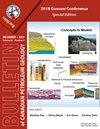Visualizing a process ichnology dataset, Lower Cretaceous McMurray Formation, NE Alberta, Canada
Q3 Earth and Planetary Sciences
引用次数: 5
Abstract
Abstract Process ichnology emphasizes the use of trace fossils as proxies for sedimentary processes and conditions. The advantage of this method is that depositional stresses can be identified based on several process-ichnological parameters. The purpose of this paper is to demonstrate the use of process-ichnology data, with a focus of establishing how process ichnology metrics can be visualized with geomodeling to aid spatial interpretation. For this study, process ichnology metrics (including bioturbation index and size diversity index), which is the product of interval ichnogenera diversity and interval maximum burrow diameter, are presented from a core dataset of the Cretaceous McMurray Formation. These data are modeled using standard geostastistical techniques for effective visualization of spatial trends. The modeled ichnology data are compared to sedimentary facies in order to interpret the dominant stresses occurring at the time of infaunal colonization. Several interpretations are made from the process ichnology model. The size diversity index and bioturbation index values from inclined heterolithic stratification show strong spatial variability related to variable depositional conditions across and along inclined heterolithic stratification bar forms. Facies interpreted to represent tidal flat deposition are distinguishable on the basis of relatively high bioturbation index values coupled with intermediate to low size diversity index values. Overall, we interpret variability in salinity and sedimentation rates to be the dominant infaunal stresses in the studied stratigraphic interval.可视化过程技术数据集,加拿大东北艾伯塔省下白垩统McMurray组
过程技术强调使用微量化石作为沉积过程和沉积条件的代用物。该方法的优点是可以根据几个工艺参数来确定沉积应力。本文的目的是演示工艺技术数据的使用,重点是建立如何通过地理建模将工艺技术度量可视化,以帮助空间解释。在本研究中,利用白垩纪McMurray组核心数据集,给出了层段生物属多样性与层段最大洞径乘积的过程技术指标(包括生物扰动指数和尺寸多样性指数)。这些数据使用标准地统计学技术建模,以便有效地可视化空间趋势。将模拟的技术数据与沉积相进行比较,以解释在动物定植时发生的主要应力。从工艺技术模型出发,提出了几种解释。倾斜异石器层状的大小多样性指数和生物扰动指数值表现出较强的空间变异性,这与沿倾斜异石器层状坝状的沉积条件变化有关。根据相对较高的生物扰动指数值和中低尺寸多样性指数值,可以区分代表潮滩沉积的相。总的来说,我们认为盐度和沉积速率的变化是研究地层间隔中主要的动物应力。
本文章由计算机程序翻译,如有差异,请以英文原文为准。
求助全文
约1分钟内获得全文
求助全文
来源期刊

Bullentin of Canadian Petroleum Geology
Earth and Planetary Sciences-Geochemistry and Petrology
CiteScore
2.50
自引率
0.00%
发文量
0
期刊介绍:
The Bulletin of Canadian Petroleum Geology is a peer-reviewed scientific journal published four times a year. Founded in 1953, the BCPG aims to be the journal of record for papers dealing with all aspects of petroleum geology, broadly conceived, with a particularly (though not exclusively) Canadian focus. International submissions are encouraged, especially where a connection can be made to Canadian examples.
 求助内容:
求助内容: 应助结果提醒方式:
应助结果提醒方式:


